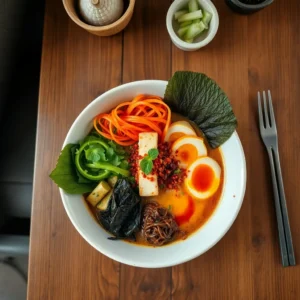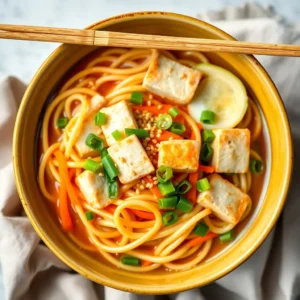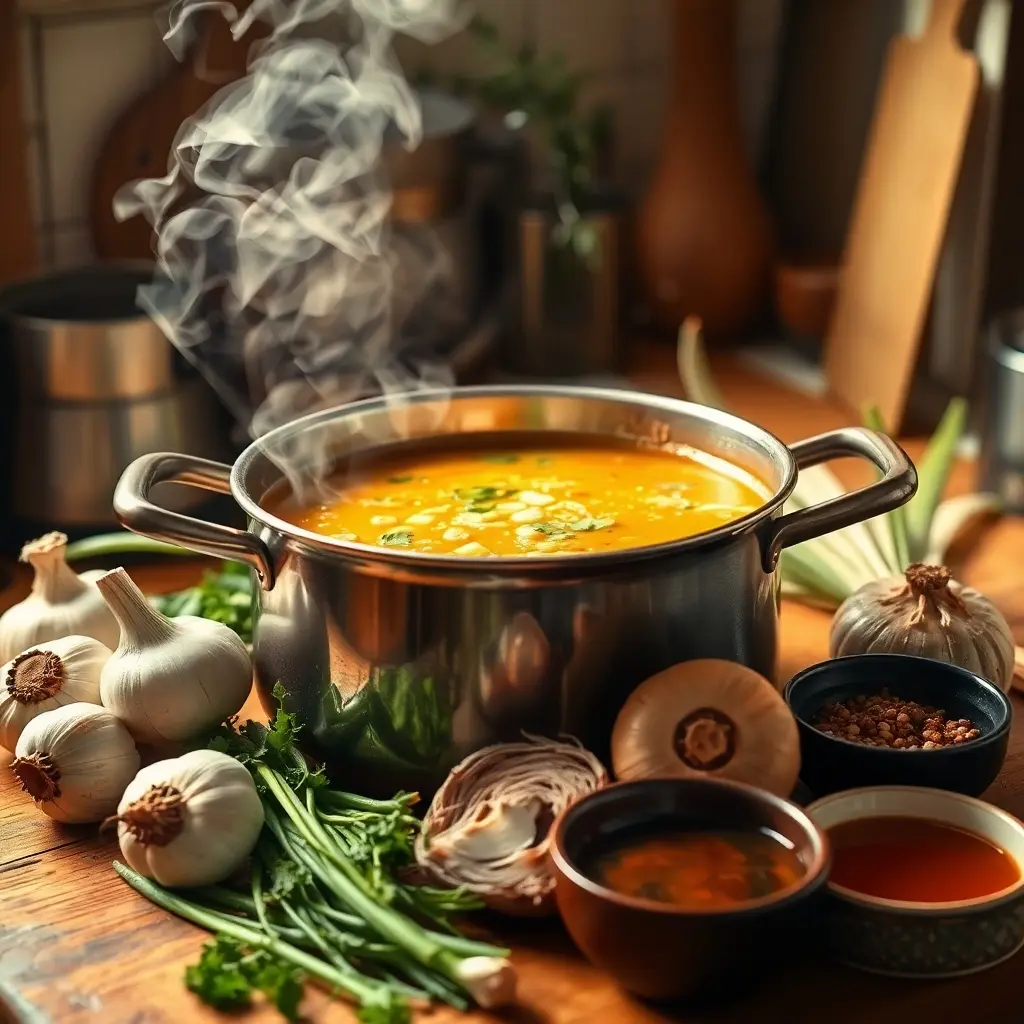Craving something warm, comforting, and packed with flavor? Vegan ramen offers a delightful twist on the traditional Japanese noodle soup. This dish replaces animal-based ingredients with plant-based alternatives that deliver the same depth of umami while being healthier and cruelty-free. Whether you’re a ramen enthusiast or new to vegan cooking, this recipe is sure to wow your taste buds. From the broth-building secrets to perfecting toppings, you’ll discover how to craft a bowl that’s as nutritious as it is delicious. Let’s dive into the details and embrace the art of making the ultimate vegan ramen recipe.
Introduction to Vegan Ramen
The Rise of Plant-Based Diets and Ramen
Plant-based eating isn’t just a trend—it’s a lifestyle shift that’s taken the culinary world by storm. Ramen, a global comfort food, has naturally adapted to this movement, giving rise to innovative vegan versions. Why vegan ramen? For starters, it’s an eco-friendly and health-conscious choice that doesn’t compromise on taste. Traditional ramen often relies on meat or fish-based broths, but vegan ramen opens a new world of savory possibilities with vegetable-based stocks, miso, and creative toppings.
What Defines Vegan Ramen?
Unlike traditional ramen, which uses animal products like pork bone broth or fish-based dashi, vegan ramen relies entirely on plant-based ingredients. The key components include noodles, a rich broth, and toppings. Vegan ramen achieves its depth of flavor by incorporating umami-rich elements such as mushrooms, kombu (dried kelp), miso, and soy sauce. The result? A bowl that’s hearty, aromatic, and just as satisfying as its non-vegan counterpart.
Vegan ramen isn’t merely a substitute, it’s a standalone dish that celebrates diversity in flavor. Whether you’re craving something spicy, creamy, or light, there’s a vegan ramen recipe tailored for you. This flexibility has made it a favorite for anyone looking to explore creative plant-based meals.
Essential Ingredients for Vegan Ramen
Noodles: Choosing the Right Type
 Noodles are the heart of any ramen dish, and for vegan ramen, the choice of noodles can make or break your bowl. Typically, traditional ramen noodles are made with wheat flour and kansui, an alkaline solution that gives them their unique springiness. But if you’re gluten-sensitive or prefer a healthier alternative, there are plenty of options! Buckwheat noodles, gluten-free rice noodles, or even whole-grain noodles can be excellent substitutes. Moreover, when selecting noodles, ensure they’re free of egg or any animal-based additives.
Noodles are the heart of any ramen dish, and for vegan ramen, the choice of noodles can make or break your bowl. Typically, traditional ramen noodles are made with wheat flour and kansui, an alkaline solution that gives them their unique springiness. But if you’re gluten-sensitive or prefer a healthier alternative, there are plenty of options! Buckwheat noodles, gluten-free rice noodles, or even whole-grain noodles can be excellent substitutes. Moreover, when selecting noodles, ensure they’re free of egg or any animal-based additives.
Broth Base: Building Umami Without Animal Products
The broth is the soul of vegan ramen—it’s where all the flavor magic happens. But without animal-based stocks, how do you achieve that savory depth? The secret lies in combining umami-rich ingredients like shiitake mushrooms, kombu (seaweed), and miso paste. Layering these flavors creates a broth that’s robust and satisfying. Additionally, adding aromatics like garlic, ginger, and onions while simmering brings out a beautifully complex taste. Soy sauce or tamari can provide that essential salty punch. For a rich, creamy base, a splash of coconut milk works wonders.
Plant-Based Proteins: Tofu, Tempeh, and More
No ramen is complete without a protein-packed topping. For vegan options, tofu, tempeh, and seitan are all fantastic choices. Firm tofu, when pan-fried or baked, adds a lovely texture that contrasts with the noodles. Meanwhile, tempeh introduces a nutty flavor that pairs beautifully with the broth. And don’t forget edamame or black beans, which are quick-to-prepare and high in protein. Incorporating these toppings ensures a hearty meal without relying on animal-derived products.
Vegetables: Adding Flavor and Nutrition
The versatility of vegan ramen truly shines with the addition of colorful vegetables. Fresh bok choy, spinach, or kale provide a healthy dose of greens, while carrots, radishes, and corn add a hint of sweetness. For those who love a smoky flavor, roasted veggies like sweet potatoes or bell peppers are a treat. It’s not just about taste—these vegetables enrich the dish with vitamins, minerals, and antioxidants, making every bowl as nutritious as it is delicious.
Step-by-Step Guide to Preparing Vegan Ramen
 Preparing the Broth
Preparing the Broth
Creating the perfect broth is the foundation of any exceptional vegan ramen recipe. To start, heat a large pot and sauté garlic, ginger, and onions in a drizzle of sesame oil. This step not only enhances the aroma but also builds a flavorful base. Next, add dried shiitake mushrooms, kombu, and soy sauce or tamari for that signature umami kick. If you want a creamier consistency, incorporating coconut milk or almond milk works well. Then, simmer the broth for at least 30 minutes to allow the flavors to meld beautifully. Finally, strain the broth, ensuring a silky smooth consistency that’s ready for your ramen noodles.
Cooking the Noodles
While the broth simmers, focus on the noodles. It’s crucial to cook them separately to maintain their texture and avoid making the soup too starchy. First, bring a pot of water to a boil, then add your chosen noodles, such as wheat or gluten-free options. Cook them according to the package instructions, but always aim for a slightly firmer texture, as they’ll soften further in the broth. Drain the noodles and rinse briefly with cold water to stop the cooking process. This step ensures the noodles stay chewy and don’t overcook when added to the hot broth.
Preparing Toppings and Garnishes
This is where your vegan ramen gets its personality! For protein, pan-fry cubes of tofu until golden, or sauté tempeh with a dash of soy sauce and sesame oil. For vegetables, blanch greens like bok choy or spinach, then thinly slice carrots and radishes for a crunchy texture. You can also roast corn or mushrooms for a smoky touch. Don’t forget garnishes—they’re small but mighty! Fresh scallions, sesame seeds, nori strips, and a drizzle of chili oil add color, texture, and bursts of flavor.
Assembling the Ramen Bowl
Now comes the fun part: putting it all together! Start by placing the noodles in a deep bowl, then ladle the steaming hot broth over them. Arrange your toppings neatly—place tofu or tempeh on one side, vegetables on another, and finish with garnishes like scallions or sesame seeds. For a spicy kick, swirl a bit of chili oil on top. Finally, serve immediately while the soup is piping hot, ensuring every bite is as satisfying as the first.
Flavor Enhancements and Variations
Incorporating Miso for Depth
If you want to elevate your vegan ramen recipe with a complex, savory flavor, miso is a must-have ingredient. This fermented soybean paste comes in different varieties, such as white, yellow, and red, each offering a distinct level of intensity. To incorporate miso into your broth, simply whisk a few tablespoons into the hot (but not boiling) broth near the end of cooking. Boiling miso can diminish its delicate taste and nutritional benefits. Whether you prefer a lighter or bolder flavor, miso delivers a satisfying umami punch that takes your ramen to the next level.
Spicy Variations: Adding Heat with Chili Oil
For those who crave a bit of heat, adding chili oil is an easy and effective way to spice things up. Drizzle a spoonful over the finished bowl, or stir it directly into the broth for a more uniform heat. Additionally, fresh chili slices, chili paste, or even a sprinkle of red pepper flakes can bring the desired level of spice. Combining these with ginger and garlic intensifies the warming effect, making your ramen a perfect choice for chilly days.
Creamy Broths: Using Coconut Milk
Sometimes, a rich and creamy broth is exactly what you need for a comforting meal. Coconut milk, with its natural sweetness and velvety texture, is an excellent addition to vegan ramen. Simply add a cup of full-fat coconut milk to your simmering broth and stir until well combined. Pair this creamy base with toppings like roasted sweet potatoes or crispy tofu to balance the flavors. Surprisingly, this variation is both indulgent and incredibly easy to prepare.
Regional Variations: Shoyu, Shio, and Miso Ramen
Did you know that ramen comes in several regional styles, each with its own unique flair? Shoyu ramen features a soy sauce-based broth that is light yet flavorful, while shio ramen relies on a salt-forward base for a clean and delicate taste. Miso ramen, as mentioned earlier, offers a robust and earthy flavor. By experimenting with these bases, you can tailor your vegan ramen to suit your mood or preferences. Incorporating regional influences allows for endless creativity while staying true to the essence of ramen.
Nutritional Information and Considerations
Calorie Content
One of the standout benefits of vegan ramen is its balanced calorie profile, making it a wholesome yet indulgent meal. Depending on the ingredients, a typical bowl contains anywhere from 300 to 500 calories, with the majority coming from the noodles, broth, and protein toppings. Using lower-calorie noodles like shirataki or spiralized vegetables can help reduce the calorie count if desired. Additionally, adding nutrient-dense vegetables ensures you’re filling up on fiber and essential vitamins without excess calories.
Macronutrient Breakdown
A well-constructed vegan ramen bowl offers a harmonious mix of macronutrients. The noodles provide complex carbohydrates for sustained energy, while the tofu, tempeh, or legumes deliver plant-based protein. Healthy fats from sesame oil, avocado, or even coconut milk not only enhance the flavor but also aid in nutrient absorption. This combination ensures you get a satisfying and complete meal without the need for animal-derived ingredients.
Vitamins and Minerals
It’s incredible how nutrient-rich a bowl of vegan ramen can be when thoughtfully prepared. Dark leafy greens like bok choy or spinach are excellent sources of vitamins A and C, while mushrooms and fortified tofu contribute valuable B vitamins, including B12. Additionally, seaweed such as kombu or nori offers iodine, an essential mineral for thyroid health. By incorporating a variety of vegetables and plant-based proteins, your ramen becomes a nutrient powerhouse.
Tips for Reducing Sodium Content
While ramen is undoubtedly delicious, it’s often criticized for its high sodium levels. To create a healthier bowl, opt for low-sodium soy sauce or tamari, and use homemade broth rather than store-bought versions. Balancing the saltiness with acidic ingredients like rice vinegar or lemon juice can enhance the overall flavor without relying heavily on salt. Finally, don’t forget to taste as you go—seasoning in layers ensures you achieve the perfect balance without overdoing it.
Frequently Asked Questions (FAQs) about Vegan Ramen
Can I Use Gluten-Free Noodles in Vegan Ramen?
Absolutely! Gluten-free noodles are an excellent choice for those with dietary restrictions or preferences. Options like rice noodles, buckwheat soba (make sure it’s 100% buckwheat), or shirataki noodles work beautifully. These alternatives not only maintain the dish’s traditional texture but also add a unique twist to the flavor profile. Just remember to follow the cooking instructions carefully, as gluten-free noodles can sometimes be more delicate than their wheat-based counterparts.
How Can I Store Leftover Vegan Ramen?
Storing leftover vegan ramen is simple, but separating the components is key to preserving its quality. Keep the broth, noodles, and toppings in separate containers to prevent sogginess. When ready to eat, reheat the broth on the stove and add the noodles and toppings just before serving. Stored this way, your ramen can stay fresh for up to three days in the refrigerator. And yes, this method ensures every bite tastes freshly made!
What Are Some Protein-Rich Toppings for Vegan Ramen?
Vegan ramen is versatile, allowing you to experiment with numerous protein-rich toppings. Tofu, whether pan-fried or baked, is a classic choice. Tempeh offers a nutty, hearty texture, while edamame adds a pop of color and protein. You could also try roasted chickpeas or lentils for a creative twist. Incorporating these toppings ensures your meal is both satisfying and nutritionally complete.
Is Vegan Ramen Suitable for a Low-Carb Diet?
While traditional ramen noodles are carb-heavy, you can modify vegan ramen to suit a low-carb diet. Spiralized zucchini, shirataki noodles, or kelp noodles make fantastic low-carb substitutes. Additionally, focusing on protein-packed toppings like tofu and low-carb vegetables such as spinach and mushrooms helps maintain balance. With a little creativity, vegan ramen can fit into almost any dietary plan.
How Can I Make My Vegan Ramen More Flavorful?
Boosting the flavor of vegan ramen is all about layering umami-rich ingredients. Add a splash of soy sauce or tamari, a dollop of miso paste, or a drizzle of sesame oil. For a spicy kick, chili oil or fresh chili slices work wonders. And don’t underestimate the power of fresh herbs—cilantro, green onions, and Thai basil can elevate the taste dramatically. Remember, tasting and adjusting as you go is the best way to achieve your desired flavor.
Are Instant Ramen Noodles Vegan?
Some instant ramen noodles are vegan, but it’s crucial to read the labels carefully. While the noodles themselves are often plant-based, the flavor packets typically contain animal-derived ingredients like chicken or beef powder. Opt for brands that specifically label their products as vegan, or simply use your favorite vegan broth with plain instant noodles for a quick, satisfying meal.

